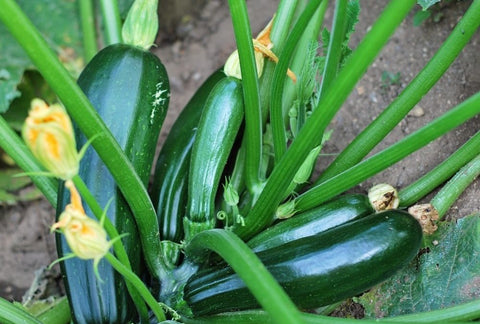It may come as a surprise, but many vegetables can grow well indoors. They need a bit more light and space than herbs or lettuce, but there’s productive and beautiful options that are well worth it. Fast growers, like cucumbers, can be first picked in just 2 months and put out 100 cucumbers per year. Longer-lived plants, like tomato and pepper, are some of the most beautiful with their dark green foliage and colorful veggies. This blog will give you an overview of your plant options, grow area, and what it’s like to have an indoor veggie garden.
What types of vegetables can you grow indoors?
Many (though not all) types of vegetables are possible to grow indoors. From a gardening perspective vegetables fall into three categories: ones you harvest as soon as the vegetables form, ones you let ripen on the vine, and ones that grow as roots.
Fast growers: cucumber, beans, and other early-harvest veggies
The easiest vegetables are a group called “Early Harvest” because they reach peak flavor right after they form. Freshness is most important with this group as they lose their sweetness quickly (sugars begin turning to starch within minutes of picking) and need to be picked at just the right time (they get pithy and tough if allowed to grow). Because they don’t need time to ripen, they’re the fastest veggies to harvest (beans and peas in 6 weeks, cucumbers in 7). The added benefit of picking them early is that it stops the plant from completing its lifecycle, which forces it to stay productive longer. Looks-wise, they tend to be a little leafy but do have nice flowers. Still, the primary reason to grow these is flavor – being able to pick them at their peak flavor and eat them immediately is only possible with homegrown vegetables.
This category includes:

Slow & steady growers: tomatoes, peppers, and other ripe veggies
These take a little more time to start harvesting but can live for years with the right care. Unlike the early-harvest vegetables, these plants don’t shut down after they ripen. In addition to being able to grow better tomatoes and peppers than you can buy, these plants have beautiful flowers, foliage, and fruits. Peppers look nice, but don’t taste that much better than store bought – though there are many more types of hot pepper that you can grow than typically. Homegrown tomatoes on the other hand are in a class of their own.
The group is:

Growing root crops
This is a bit of a grab bag, but several root vegetables grow well indoors. Garlic can be grown for their greens or the bulb. Radishes are also well-suited and give a quick and easy return. Even though they look similar, we steer away from carrots because they take much longer and require more sun. Ginger and turmeric have slightly higher light needs, but are also great indoor plants.

A seed ain’t a seed: cultivar recommendations
More so than other plants, picking the right cultivated variety – known as a cultivar – is critical to having a plant that is manageable and productive in indoor conditions. This group has lots of plants that grow as vines and bushes, and outdoors will grow massive. While pruning can help keep things under control, picking cultivars that are bred to grow in small spaces and lower light will ensure you make the most out of your limited indoor space. We offer specific cultivar recommendations in the plant specific guides.
Setup & supplies for an indoor vegetable garden
What’s the ideal light to grow vegetables?
Vegetables need lots of light to grow, and even more to be productive. You may be able to grow them with natural light, especially if you start in spring in a very bright window, but most people need to use a grow light. Grow lights are a good match for vegetable plants because they can be lit for 12 hours (or longer) – for some vegetables, this “day length” is a signal that it’s time to grow vegetables. All vegetables have about the same light needs, so once you know how to use indoor light for vegetables you can grow them all.
What type of planters & soil should you use?
We recommend filling a ceramic self watering planter with a standard potting mix for all vegetables. We’ve tried all sorts of hydroponic and planters, and have found them to be the simplest and most reliable. The early harvest and root vegetables are simple enough, you’ll just keep the soil consistently moist and a regular fertilizer schedule. There’s a small trick to ripe vegetables – they’re much sweeter if they ripen with drier soil, and the ceramic self watering planter lets you easily control this. We’ve got complete setup & maintenance guides for all types of vegetables.
Growing & harvesting your indoor veggies
Pruning & picking for long productive harvests
Knowing when to harvest your vegetable is the key to unlocking crisp, sweet produce. You’ll learn to recognize color changes, firmness, and develop a sense for when they “just feel ripe.” They will look different than produce in the supermarket which is almost never picked at peak ripeness – they’re more concerned with size and how well it ships – so if this is your first time in the garden be sure to read about harvesting for peak flavor.
Using your fresh vegetables in the kitchen
If you’re like us, most of your peas and cherry tomatoes will go straight from your plant to mouth. If you are looking for more inspiration – our recipe section [coming soon] has lots of ideas for making the most out of your fresh grown produce.











There are no comments for this article. Be the first one to leave a message!